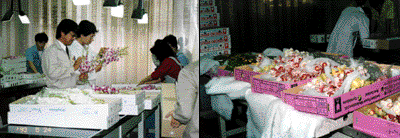
The growing fondness among the Japanese for cut flowers has pushed demand beyond supply and resulted in a steady rise in imports. In 1994 the total value of imports came to 20 billion yen, 3.8 times more than a decade earlier.
Cut flowers were initially purchased from abroad to offer varieties not grown in Japan and supplement domestic stocks during off-seasons. Today, however, they play a vital role in ensuring selection, stable supplies, and low prices year-round.
According to industry statistics, imported cut flowers comprised 9.6% of the total domestic supply in 1994. Japan bought a substantial volume of orchids from Thailand and Singapore; lilies; freesias; tulips from the Netherlands; chrysanthemums; gladiolas from Taiwan; calla lilies from New Zealand; and wax flowers from Australia.
Southeast Asia and Oceania continue to be important importers to Japan, but the list of countries is growing fast, thanks to the rapid rise in the value of the yen and improvements in transportation. Today Japan purchases cut flowers from 40 countries, compared with just 5 countries 20 years ago. Transporting goods from one side of the globe to another is now a simple procedure; shipments of roses from Kenya reach Japan in just 20 hours.
Imports appear on the market in greatest quantity from October to December, when domestic flowers are in short supply. During these months some 20% of florists' offerings come from abroad, most from the southern hemisphere. Imports of spray chrysanthemums from Taiwan and other countries are particularly high in March, August, and September, when Japanese families offer flowers at family graves and in other Buddhist memorial services. The shortage of chrysanthemums following the extended heat wave in the summer of 1994 led suppliers to buy up spray chrysanthemums from the Netherlands and elsewhere to tide over the crisis. On Mother's Day, the holiday on the second Sunday in May when children customarily give their mothers carnations, florists overflow with varieties from Spain and Columbia.
Cut flowers for personal use comprise about 30% of the total. About half are used as offerings at the graves of family members or Buddhist altars in the home. However, vases of flowers have begun to grace a growing number of tables and homes, and it has become common for people to replace flowers regularly. Per capita consumption in Japan is still lower than that in the United States or Europe, but suppliers believe that the use of cut flowers in the home will spread and imports will continue to expand.
(The above article, edited by Japan Echo Inc., is based on domestic Japanese news sources. It is offered for reference purposes and does not necessarily represent the policy or views of the Japanese Government.)